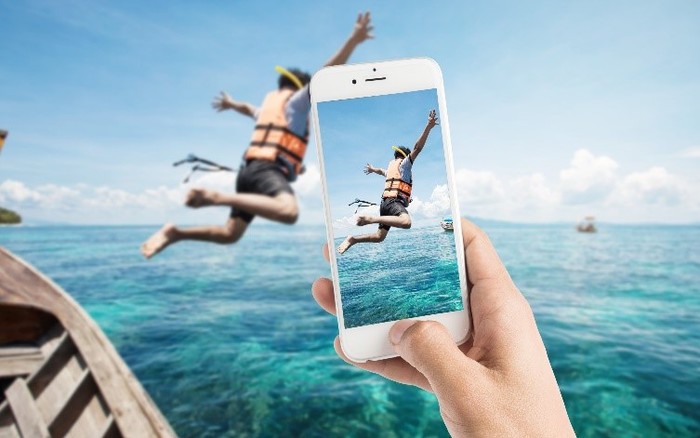The Best Tips for Capturing On-the-Water Action

Seeing is believing… especially when it comes to amazing on-the-water moments.
The flips, tricks, and runs that you wouldn’t think were possible if you didn’t ride them yourself.
Fortunately, with modern technology at your disposal, there’s a myriad of ways to capture those amazing aerials and unforgettable flips—and they might be more accessible than you think. Read on for our top tips on finding the right tools of the trade… and, of course, developing an eye for the action. Take a look.
Choose your photographer
Choosing your photographer is easy, right? Just choose the spotter or anyone else on board who’s not busy or trying to hold onto a tow rope handle…
Well, not exactly! Your spotter can certainly be a great photographer since they already have their eyes on you and can capture some seriously great front-facing shots. And that’s a good thing. (Action shots are cool, but what really makes a picture “pop” is often seeing the expression of a surfer or boarder as they carve, splash or tumble off.)
But this isn’t the only option. Some action cameras are built to go just about anywhere. For example, you can attach a GoPro-style camera to your Vortex’s sleek Folding Arch Tower. This will give your photos some more depth—showing the lay of the land (perfect for shooting in unique natural environments you want to remember) as well as, of course, your skills on the water.
You can even attach such a camera to a helmet as you ride! Do so safely, so that you’re used to the weight and feel of the camera, before hitting the water. When you want to capture unique point-of-view videos for your skills reel, this is a tactic that can’t be beaten.
Find the right “stuff”
We always talk about wakeboarders or surfers having the right “stuff” to make it in the sport. But for photography, you’ll also need the right stuff—the right gear, that is. Like we mentioned above, action cameras that are built for a rough life on and off the water make for a great option, as do accessories that let you customize your shot (helmets, straps, etc.). But for many newcomers to the world of water photography, you won’t need much more than your phone to get started. Just be sure to invest in a waterproof case so that you can snap safely!
All about the angles
If you’re serving as a photographer, you’ll want to get all the right angles. Shooting from a slightly lower angle, instead of straight-on, makes the subject look especially impressive as they do aerials and other stylish maneuvers. And of course, we need to consider light. For on-the-water photo sessions, you may want to try boating toward the direction of the sun in its “golden” hour (i.e. softer light), so that the subject’s face and posture is well-lit for photos.
Try a bird’s eye view
Speaking of angles, why not try a bird’s eye view? This especially stylistic choice can be achieved with some handy technology—namely, camera drones that capture the movement from above so that you can get a complete look at the water, the wake, the flips, and turns… everything that shapes a stellar on-the-water experience.
Snap, snap, snap
On a professional camera, you’ll want to choose a high shutter speed setting. Some of the best maneuvers take only seconds to complete, so you’ll want a camera that works just as fast in capturing them as crisply as possible.
If you’re shooting with your phone, a great way to replicate the shutter speed’s function (and to ensure that you don’t miss a move) is to take pictures in “bursts.” Hold down your phone’s camera button so you get a photo-by-photo montage of a maneuver, giving you a range of shots to sift through. Just make sure you have enough memory to store it all!
The key to composition
When composing shots, there are a few things you’ll want to capture that are easy to forget. First off, faces—like we mentioned before, it’s easy to get caught up in the style of a flip or trick and miss out on capturing the subject’s expression, which is key for the character of your photos.
Also, be sure to capture some of the background to achieve a choice depth of field. Sharp, stunning moves look even better against the soft, gently out-of-focus backdrop of gorgeous shoreline trees, mountains or cityscapes.
Finally, to mix things up, try to capture off-center photos—this will add some dimension to the scenes you shoot. If your subject is carving right, for example, leave some space in the direction where they are going (in this case, to their right). This is another great way to add a helpful dimension and to tell a story with your photos.
“Develop” your shots
No, we’re not talking about the old-fashioned photo development process. Digital tools let us capture photos in an instant, but all great photographers start out slowly—working their way up to shots that truly “wow” friends, family and the World Wide Web. Take time to practice catching those great moments on the water, and your photos will speak for themselves.
With these tips and a trusty camera, you’re well on your way to capturing amazing aquatic feats—and, of course, earning some bragging rights along the way.
Bookmark & Share
Previous Article
Next Article
